Quantitative Methods Report: Decision Making, Case Study Analysis
VerifiedAdded on 2020/04/15
|6
|1505
|87
Report
AI Summary
This report delves into the crucial role of quantitative methods in business decision-making. It outlines the steps involved in problem-solving and decision-making processes, emphasizing the challenges posed by market variables and uncertainty. The report highlights the significance of quantitative techniques in objectively evaluating choices, thereby improving decision quality. It covers the different stages of decision making, from problem recognition to implementation and feedback, and then explores various quantitative methods such as statistical techniques. The core of the report focuses on the relationship between quantitative methods and decision-making, particularly in evaluating alternatives. A case study from the Journal of Political Economy, using regression analysis to predict radio station prices, illustrates the practical application of these methods. The report concludes by underscoring the critical support quantitative methods provide to decision-makers in evaluating alternatives, backed by empirical data and real-world examples.
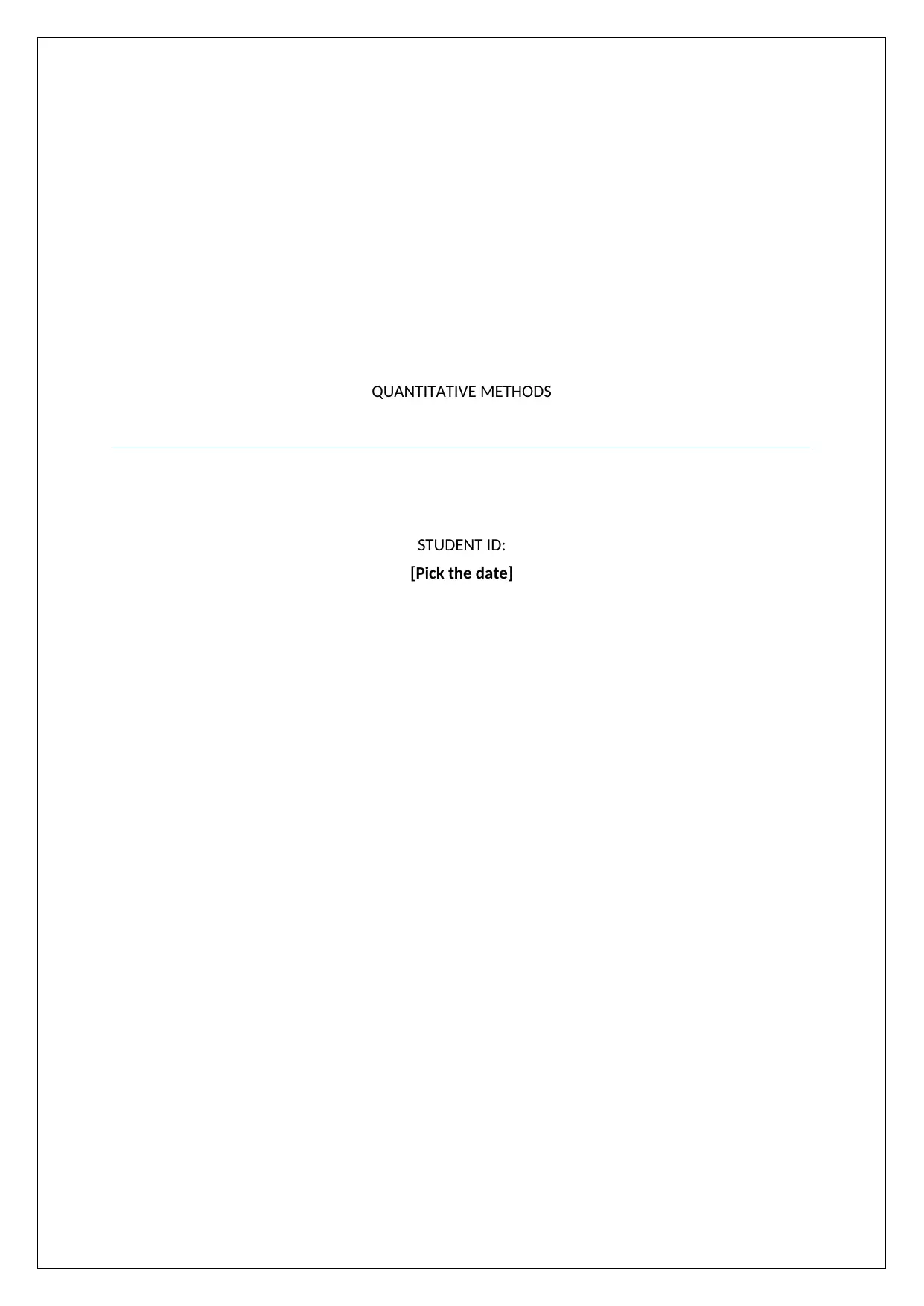
QUANTITATIVE METHODS
STUDENT ID:
[Pick the date]
STUDENT ID:
[Pick the date]
Paraphrase This Document
Need a fresh take? Get an instant paraphrase of this document with our AI Paraphraser
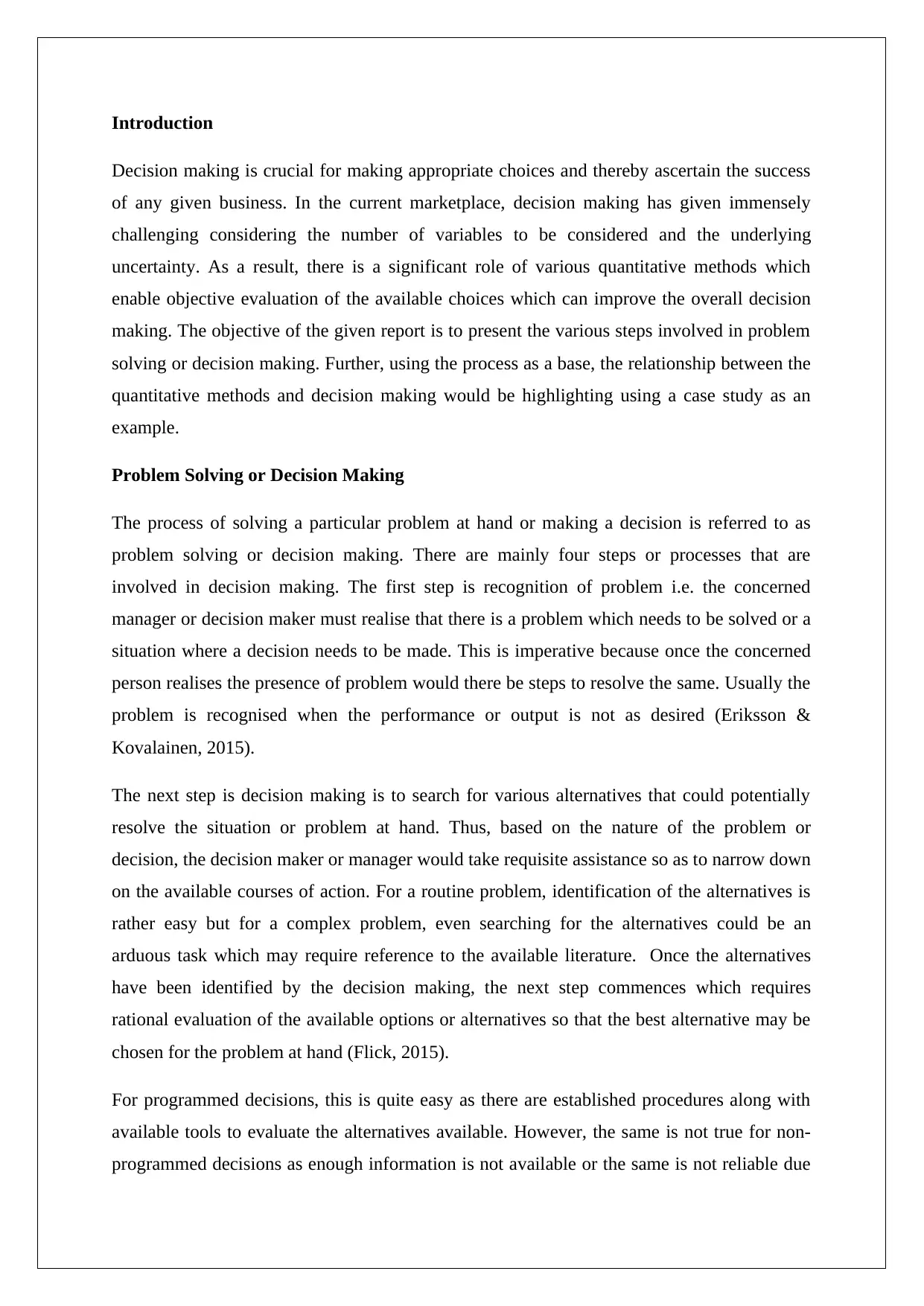
Introduction
Decision making is crucial for making appropriate choices and thereby ascertain the success
of any given business. In the current marketplace, decision making has given immensely
challenging considering the number of variables to be considered and the underlying
uncertainty. As a result, there is a significant role of various quantitative methods which
enable objective evaluation of the available choices which can improve the overall decision
making. The objective of the given report is to present the various steps involved in problem
solving or decision making. Further, using the process as a base, the relationship between the
quantitative methods and decision making would be highlighting using a case study as an
example.
Problem Solving or Decision Making
The process of solving a particular problem at hand or making a decision is referred to as
problem solving or decision making. There are mainly four steps or processes that are
involved in decision making. The first step is recognition of problem i.e. the concerned
manager or decision maker must realise that there is a problem which needs to be solved or a
situation where a decision needs to be made. This is imperative because once the concerned
person realises the presence of problem would there be steps to resolve the same. Usually the
problem is recognised when the performance or output is not as desired (Eriksson &
Kovalainen, 2015).
The next step is decision making is to search for various alternatives that could potentially
resolve the situation or problem at hand. Thus, based on the nature of the problem or
decision, the decision maker or manager would take requisite assistance so as to narrow down
on the available courses of action. For a routine problem, identification of the alternatives is
rather easy but for a complex problem, even searching for the alternatives could be an
arduous task which may require reference to the available literature. Once the alternatives
have been identified by the decision making, the next step commences which requires
rational evaluation of the available options or alternatives so that the best alternative may be
chosen for the problem at hand (Flick, 2015).
For programmed decisions, this is quite easy as there are established procedures along with
available tools to evaluate the alternatives available. However, the same is not true for non-
programmed decisions as enough information is not available or the same is not reliable due
Decision making is crucial for making appropriate choices and thereby ascertain the success
of any given business. In the current marketplace, decision making has given immensely
challenging considering the number of variables to be considered and the underlying
uncertainty. As a result, there is a significant role of various quantitative methods which
enable objective evaluation of the available choices which can improve the overall decision
making. The objective of the given report is to present the various steps involved in problem
solving or decision making. Further, using the process as a base, the relationship between the
quantitative methods and decision making would be highlighting using a case study as an
example.
Problem Solving or Decision Making
The process of solving a particular problem at hand or making a decision is referred to as
problem solving or decision making. There are mainly four steps or processes that are
involved in decision making. The first step is recognition of problem i.e. the concerned
manager or decision maker must realise that there is a problem which needs to be solved or a
situation where a decision needs to be made. This is imperative because once the concerned
person realises the presence of problem would there be steps to resolve the same. Usually the
problem is recognised when the performance or output is not as desired (Eriksson &
Kovalainen, 2015).
The next step is decision making is to search for various alternatives that could potentially
resolve the situation or problem at hand. Thus, based on the nature of the problem or
decision, the decision maker or manager would take requisite assistance so as to narrow down
on the available courses of action. For a routine problem, identification of the alternatives is
rather easy but for a complex problem, even searching for the alternatives could be an
arduous task which may require reference to the available literature. Once the alternatives
have been identified by the decision making, the next step commences which requires
rational evaluation of the available options or alternatives so that the best alternative may be
chosen for the problem at hand (Flick, 2015).
For programmed decisions, this is quite easy as there are established procedures along with
available tools to evaluate the alternatives available. However, the same is not true for non-
programmed decisions as enough information is not available or the same is not reliable due
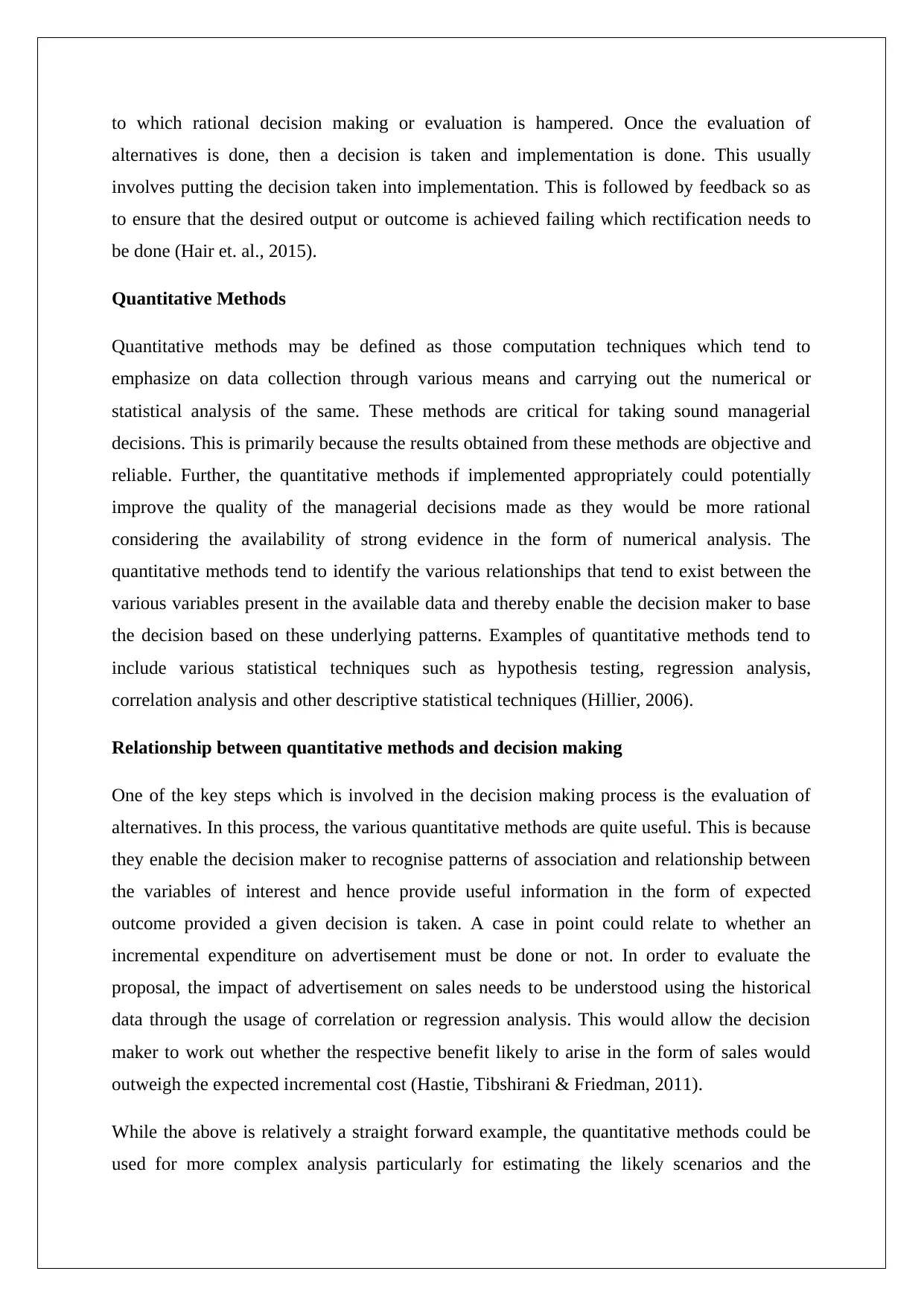
to which rational decision making or evaluation is hampered. Once the evaluation of
alternatives is done, then a decision is taken and implementation is done. This usually
involves putting the decision taken into implementation. This is followed by feedback so as
to ensure that the desired output or outcome is achieved failing which rectification needs to
be done (Hair et. al., 2015).
Quantitative Methods
Quantitative methods may be defined as those computation techniques which tend to
emphasize on data collection through various means and carrying out the numerical or
statistical analysis of the same. These methods are critical for taking sound managerial
decisions. This is primarily because the results obtained from these methods are objective and
reliable. Further, the quantitative methods if implemented appropriately could potentially
improve the quality of the managerial decisions made as they would be more rational
considering the availability of strong evidence in the form of numerical analysis. The
quantitative methods tend to identify the various relationships that tend to exist between the
various variables present in the available data and thereby enable the decision maker to base
the decision based on these underlying patterns. Examples of quantitative methods tend to
include various statistical techniques such as hypothesis testing, regression analysis,
correlation analysis and other descriptive statistical techniques (Hillier, 2006).
Relationship between quantitative methods and decision making
One of the key steps which is involved in the decision making process is the evaluation of
alternatives. In this process, the various quantitative methods are quite useful. This is because
they enable the decision maker to recognise patterns of association and relationship between
the variables of interest and hence provide useful information in the form of expected
outcome provided a given decision is taken. A case in point could relate to whether an
incremental expenditure on advertisement must be done or not. In order to evaluate the
proposal, the impact of advertisement on sales needs to be understood using the historical
data through the usage of correlation or regression analysis. This would allow the decision
maker to work out whether the respective benefit likely to arise in the form of sales would
outweigh the expected incremental cost (Hastie, Tibshirani & Friedman, 2011).
While the above is relatively a straight forward example, the quantitative methods could be
used for more complex analysis particularly for estimating the likely scenarios and the
alternatives is done, then a decision is taken and implementation is done. This usually
involves putting the decision taken into implementation. This is followed by feedback so as
to ensure that the desired output or outcome is achieved failing which rectification needs to
be done (Hair et. al., 2015).
Quantitative Methods
Quantitative methods may be defined as those computation techniques which tend to
emphasize on data collection through various means and carrying out the numerical or
statistical analysis of the same. These methods are critical for taking sound managerial
decisions. This is primarily because the results obtained from these methods are objective and
reliable. Further, the quantitative methods if implemented appropriately could potentially
improve the quality of the managerial decisions made as they would be more rational
considering the availability of strong evidence in the form of numerical analysis. The
quantitative methods tend to identify the various relationships that tend to exist between the
various variables present in the available data and thereby enable the decision maker to base
the decision based on these underlying patterns. Examples of quantitative methods tend to
include various statistical techniques such as hypothesis testing, regression analysis,
correlation analysis and other descriptive statistical techniques (Hillier, 2006).
Relationship between quantitative methods and decision making
One of the key steps which is involved in the decision making process is the evaluation of
alternatives. In this process, the various quantitative methods are quite useful. This is because
they enable the decision maker to recognise patterns of association and relationship between
the variables of interest and hence provide useful information in the form of expected
outcome provided a given decision is taken. A case in point could relate to whether an
incremental expenditure on advertisement must be done or not. In order to evaluate the
proposal, the impact of advertisement on sales needs to be understood using the historical
data through the usage of correlation or regression analysis. This would allow the decision
maker to work out whether the respective benefit likely to arise in the form of sales would
outweigh the expected incremental cost (Hastie, Tibshirani & Friedman, 2011).
While the above is relatively a straight forward example, the quantitative methods could be
used for more complex analysis particularly for estimating the likely scenarios and the
⊘ This is a preview!⊘
Do you want full access?
Subscribe today to unlock all pages.

Trusted by 1+ million students worldwide
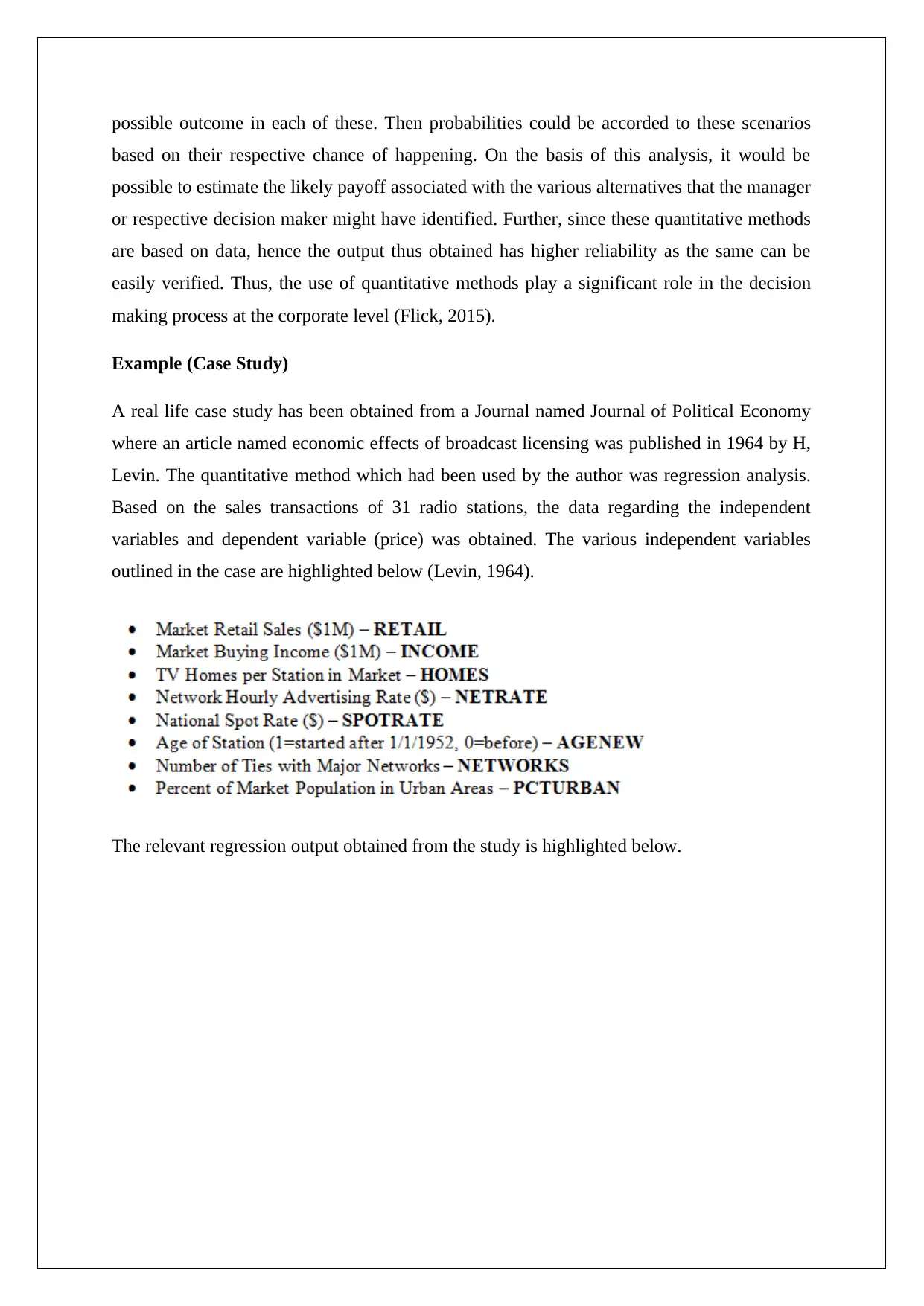
possible outcome in each of these. Then probabilities could be accorded to these scenarios
based on their respective chance of happening. On the basis of this analysis, it would be
possible to estimate the likely payoff associated with the various alternatives that the manager
or respective decision maker might have identified. Further, since these quantitative methods
are based on data, hence the output thus obtained has higher reliability as the same can be
easily verified. Thus, the use of quantitative methods play a significant role in the decision
making process at the corporate level (Flick, 2015).
Example (Case Study)
A real life case study has been obtained from a Journal named Journal of Political Economy
where an article named economic effects of broadcast licensing was published in 1964 by H,
Levin. The quantitative method which had been used by the author was regression analysis.
Based on the sales transactions of 31 radio stations, the data regarding the independent
variables and dependent variable (price) was obtained. The various independent variables
outlined in the case are highlighted below (Levin, 1964).
The relevant regression output obtained from the study is highlighted below.
based on their respective chance of happening. On the basis of this analysis, it would be
possible to estimate the likely payoff associated with the various alternatives that the manager
or respective decision maker might have identified. Further, since these quantitative methods
are based on data, hence the output thus obtained has higher reliability as the same can be
easily verified. Thus, the use of quantitative methods play a significant role in the decision
making process at the corporate level (Flick, 2015).
Example (Case Study)
A real life case study has been obtained from a Journal named Journal of Political Economy
where an article named economic effects of broadcast licensing was published in 1964 by H,
Levin. The quantitative method which had been used by the author was regression analysis.
Based on the sales transactions of 31 radio stations, the data regarding the independent
variables and dependent variable (price) was obtained. The various independent variables
outlined in the case are highlighted below (Levin, 1964).
The relevant regression output obtained from the study is highlighted below.
Paraphrase This Document
Need a fresh take? Get an instant paraphrase of this document with our AI Paraphraser
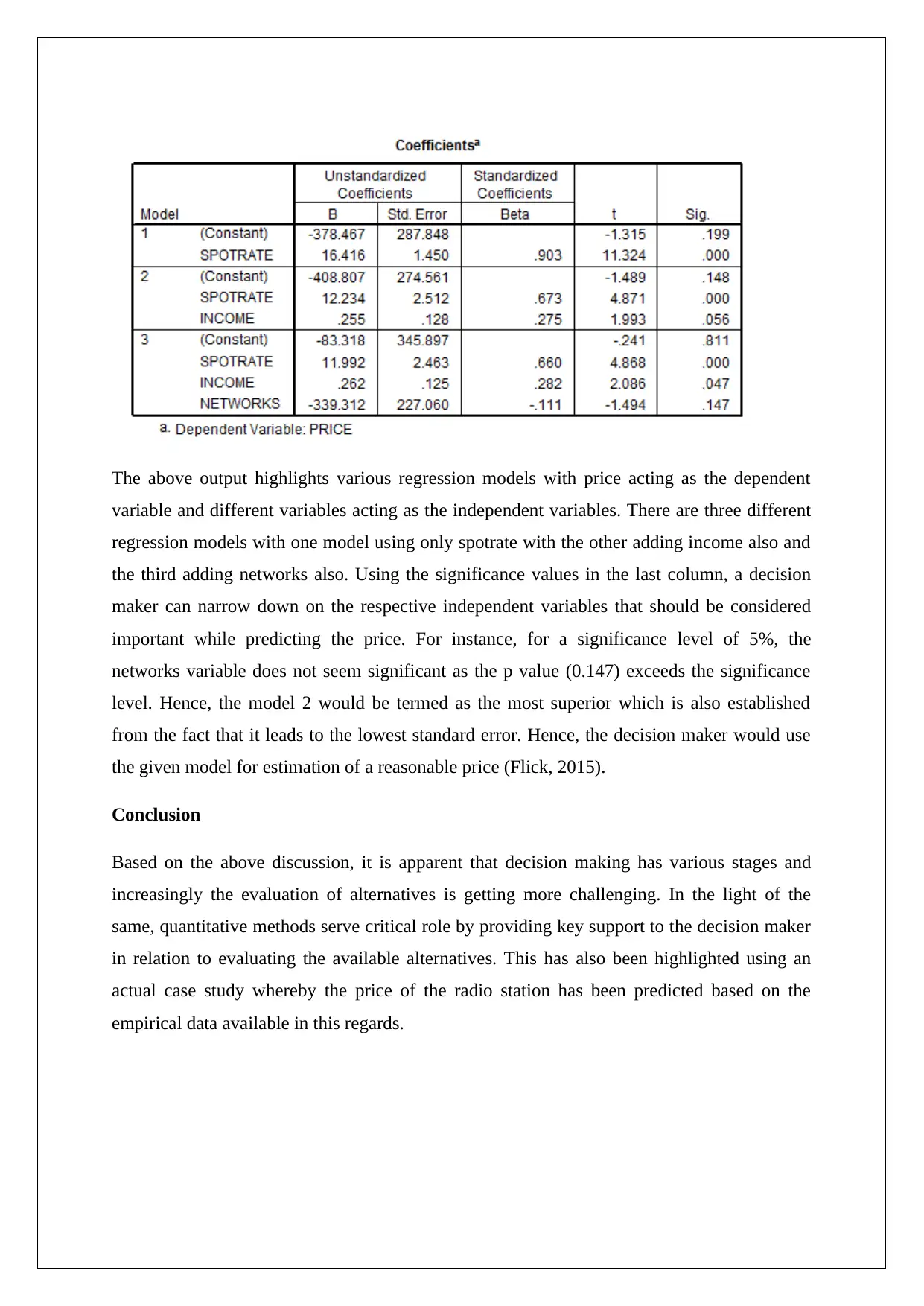
The above output highlights various regression models with price acting as the dependent
variable and different variables acting as the independent variables. There are three different
regression models with one model using only spotrate with the other adding income also and
the third adding networks also. Using the significance values in the last column, a decision
maker can narrow down on the respective independent variables that should be considered
important while predicting the price. For instance, for a significance level of 5%, the
networks variable does not seem significant as the p value (0.147) exceeds the significance
level. Hence, the model 2 would be termed as the most superior which is also established
from the fact that it leads to the lowest standard error. Hence, the decision maker would use
the given model for estimation of a reasonable price (Flick, 2015).
Conclusion
Based on the above discussion, it is apparent that decision making has various stages and
increasingly the evaluation of alternatives is getting more challenging. In the light of the
same, quantitative methods serve critical role by providing key support to the decision maker
in relation to evaluating the available alternatives. This has also been highlighted using an
actual case study whereby the price of the radio station has been predicted based on the
empirical data available in this regards.
variable and different variables acting as the independent variables. There are three different
regression models with one model using only spotrate with the other adding income also and
the third adding networks also. Using the significance values in the last column, a decision
maker can narrow down on the respective independent variables that should be considered
important while predicting the price. For instance, for a significance level of 5%, the
networks variable does not seem significant as the p value (0.147) exceeds the significance
level. Hence, the model 2 would be termed as the most superior which is also established
from the fact that it leads to the lowest standard error. Hence, the decision maker would use
the given model for estimation of a reasonable price (Flick, 2015).
Conclusion
Based on the above discussion, it is apparent that decision making has various stages and
increasingly the evaluation of alternatives is getting more challenging. In the light of the
same, quantitative methods serve critical role by providing key support to the decision maker
in relation to evaluating the available alternatives. This has also been highlighted using an
actual case study whereby the price of the radio station has been predicted based on the
empirical data available in this regards.
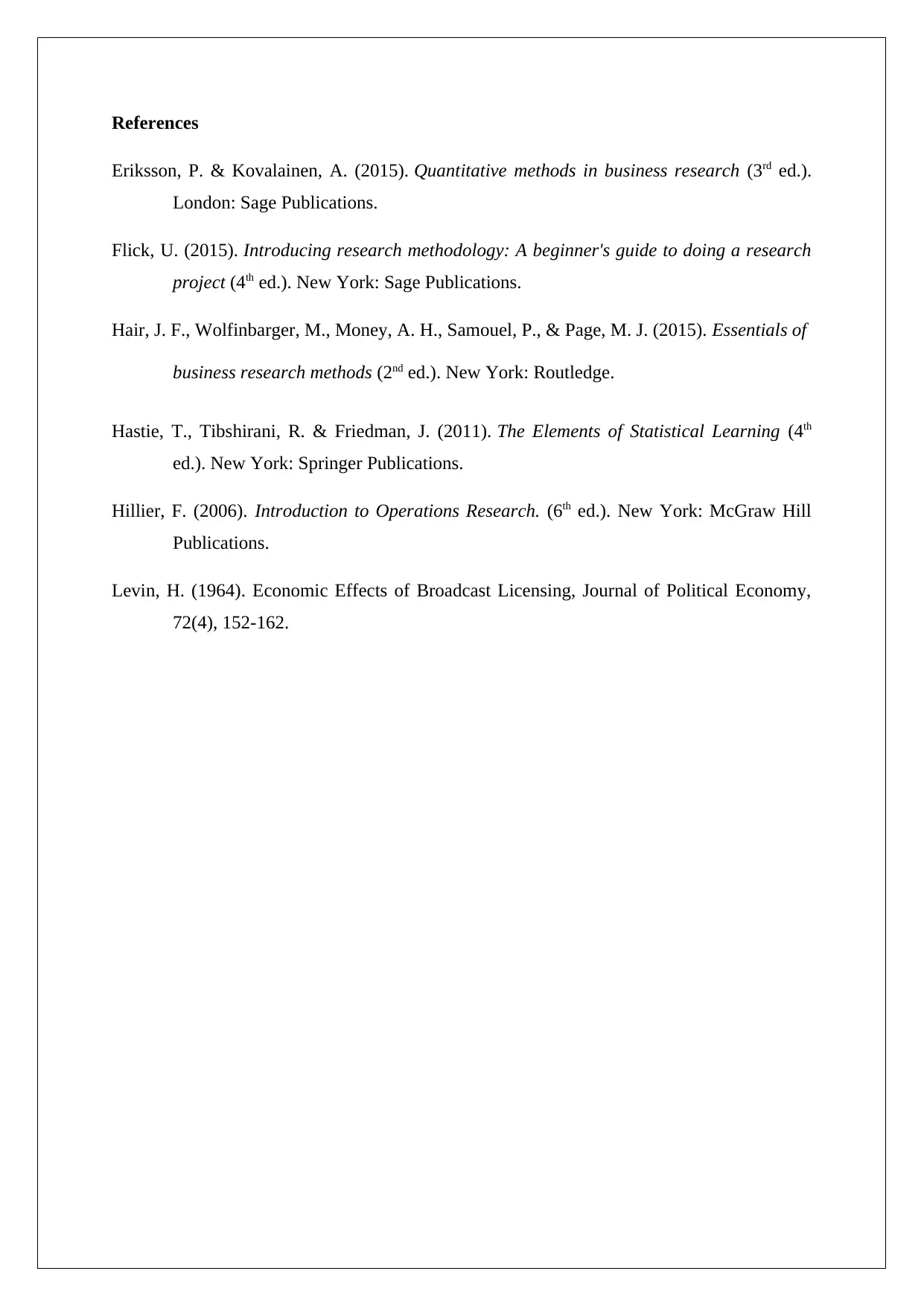
References
Eriksson, P. & Kovalainen, A. (2015). Quantitative methods in business research (3rd ed.).
London: Sage Publications.
Flick, U. (2015). Introducing research methodology: A beginner's guide to doing a research
project (4th ed.). New York: Sage Publications.
Hair, J. F., Wolfinbarger, M., Money, A. H., Samouel, P., & Page, M. J. (2015). Essentials of
business research methods (2nd ed.). New York: Routledge.
Hastie, T., Tibshirani, R. & Friedman, J. (2011). The Elements of Statistical Learning (4th
ed.). New York: Springer Publications.
Hillier, F. (2006). Introduction to Operations Research. (6th ed.). New York: McGraw Hill
Publications.
Levin, H. (1964). Economic Effects of Broadcast Licensing, Journal of Political Economy,
72(4), 152-162.
Eriksson, P. & Kovalainen, A. (2015). Quantitative methods in business research (3rd ed.).
London: Sage Publications.
Flick, U. (2015). Introducing research methodology: A beginner's guide to doing a research
project (4th ed.). New York: Sage Publications.
Hair, J. F., Wolfinbarger, M., Money, A. H., Samouel, P., & Page, M. J. (2015). Essentials of
business research methods (2nd ed.). New York: Routledge.
Hastie, T., Tibshirani, R. & Friedman, J. (2011). The Elements of Statistical Learning (4th
ed.). New York: Springer Publications.
Hillier, F. (2006). Introduction to Operations Research. (6th ed.). New York: McGraw Hill
Publications.
Levin, H. (1964). Economic Effects of Broadcast Licensing, Journal of Political Economy,
72(4), 152-162.
⊘ This is a preview!⊘
Do you want full access?
Subscribe today to unlock all pages.

Trusted by 1+ million students worldwide
1 out of 6
Related Documents
Your All-in-One AI-Powered Toolkit for Academic Success.
+13062052269
info@desklib.com
Available 24*7 on WhatsApp / Email
![[object Object]](/_next/static/media/star-bottom.7253800d.svg)
Unlock your academic potential
Copyright © 2020–2025 A2Z Services. All Rights Reserved. Developed and managed by ZUCOL.




